Financial Management and Decision Making: Analysis and Evaluation
VerifiedAdded on 2023/06/18
|7
|1312
|367
AI Summary
This report examines various factors related to financial management and decision making that can add value to a company in the long run. It includes calculations of market values, net present value, cost of WACC, and more. It also discusses activity-based pricing, CVP analytics, budgeting management, and methods of getting finances. The stakeholder approach is also explored.
Contribute Materials
Your contribution can guide someone’s learning journey. Share your
documents today.

Financial management
decision making
decision making
Secure Best Marks with AI Grader
Need help grading? Try our AI Grader for instant feedback on your assignments.

Contents
Contents...........................................................................................................................................2
INTRODUCTION...........................................................................................................................1
MAIN BODY..................................................................................................................................1
Question 1....................................................................................................................................1
Question 2....................................................................................................................................3
Question 3....................................................................................................................................3
Question 4....................................................................................................................................4
Question 5....................................................................................................................................4
CONCLUSION................................................................................................................................4
REFERENCES................................................................................................................................5
Contents...........................................................................................................................................2
INTRODUCTION...........................................................................................................................1
MAIN BODY..................................................................................................................................1
Question 1....................................................................................................................................1
Question 2....................................................................................................................................3
Question 3....................................................................................................................................3
Question 4....................................................................................................................................4
Question 5....................................................................................................................................4
CONCLUSION................................................................................................................................4
REFERENCES................................................................................................................................5
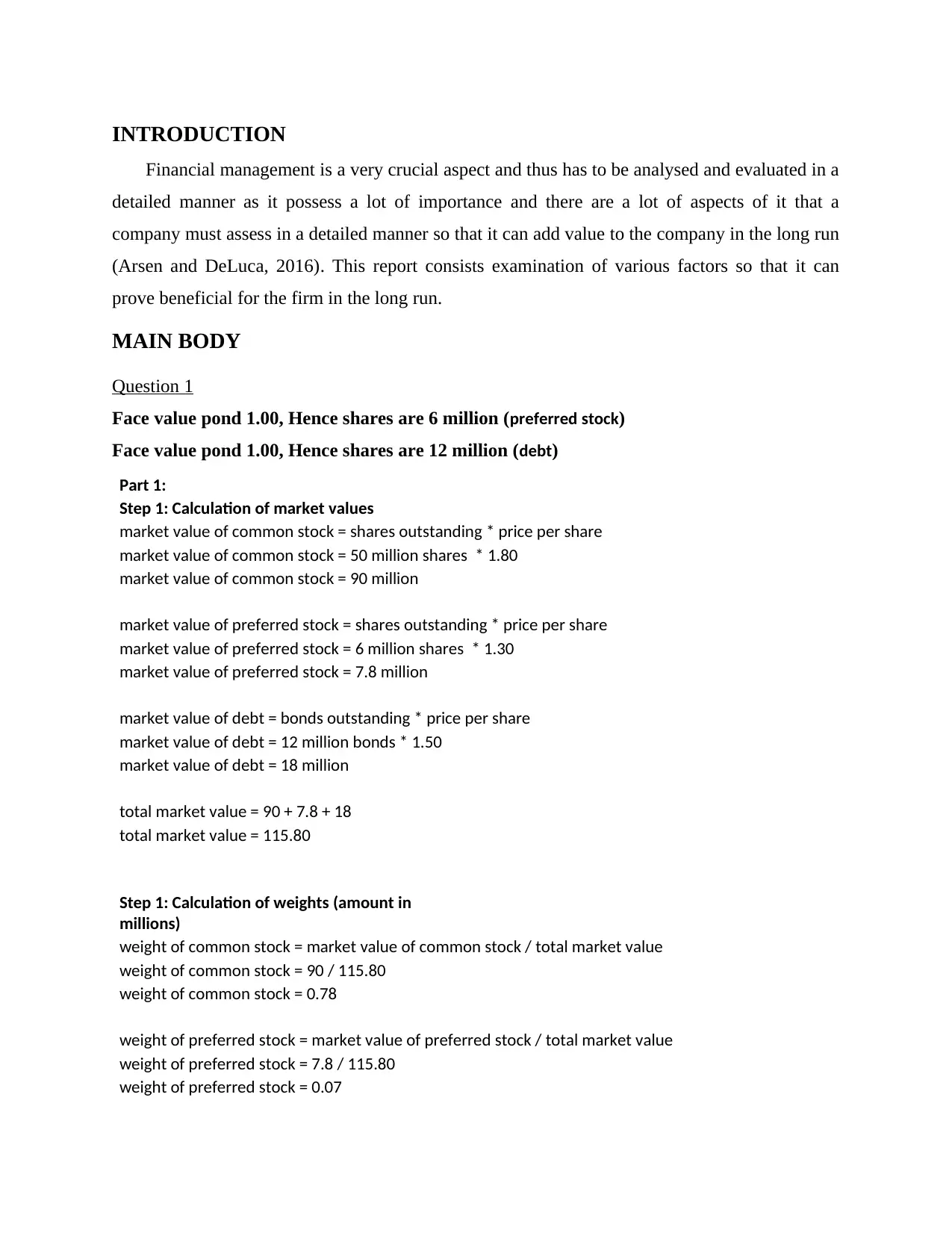
INTRODUCTION
Financial management is a very crucial aspect and thus has to be analysed and evaluated in a
detailed manner as it possess a lot of importance and there are a lot of aspects of it that a
company must assess in a detailed manner so that it can add value to the company in the long run
(Arsen and DeLuca, 2016). This report consists examination of various factors so that it can
prove beneficial for the firm in the long run.
MAIN BODY
Question 1
Face value pond 1.00, Hence shares are 6 million (preferred stock)
Face value pond 1.00, Hence shares are 12 million (debt)
Part 1:
Step 1: Calculation of market values
market value of common stock = shares outstanding * price per share
market value of common stock = 50 million shares * 1.80
market value of common stock = 90 million
market value of preferred stock = shares outstanding * price per share
market value of preferred stock = 6 million shares * 1.30
market value of preferred stock = 7.8 million
market value of debt = bonds outstanding * price per share
market value of debt = 12 million bonds * 1.50
market value of debt = 18 million
total market value = 90 + 7.8 + 18
total market value = 115.80
Step 1: Calculation of weights (amount in
millions)
weight of common stock = market value of common stock / total market value
weight of common stock = 90 / 115.80
weight of common stock = 0.78
weight of preferred stock = market value of preferred stock / total market value
weight of preferred stock = 7.8 / 115.80
weight of preferred stock = 0.07
Financial management is a very crucial aspect and thus has to be analysed and evaluated in a
detailed manner as it possess a lot of importance and there are a lot of aspects of it that a
company must assess in a detailed manner so that it can add value to the company in the long run
(Arsen and DeLuca, 2016). This report consists examination of various factors so that it can
prove beneficial for the firm in the long run.
MAIN BODY
Question 1
Face value pond 1.00, Hence shares are 6 million (preferred stock)
Face value pond 1.00, Hence shares are 12 million (debt)
Part 1:
Step 1: Calculation of market values
market value of common stock = shares outstanding * price per share
market value of common stock = 50 million shares * 1.80
market value of common stock = 90 million
market value of preferred stock = shares outstanding * price per share
market value of preferred stock = 6 million shares * 1.30
market value of preferred stock = 7.8 million
market value of debt = bonds outstanding * price per share
market value of debt = 12 million bonds * 1.50
market value of debt = 18 million
total market value = 90 + 7.8 + 18
total market value = 115.80
Step 1: Calculation of weights (amount in
millions)
weight of common stock = market value of common stock / total market value
weight of common stock = 90 / 115.80
weight of common stock = 0.78
weight of preferred stock = market value of preferred stock / total market value
weight of preferred stock = 7.8 / 115.80
weight of preferred stock = 0.07
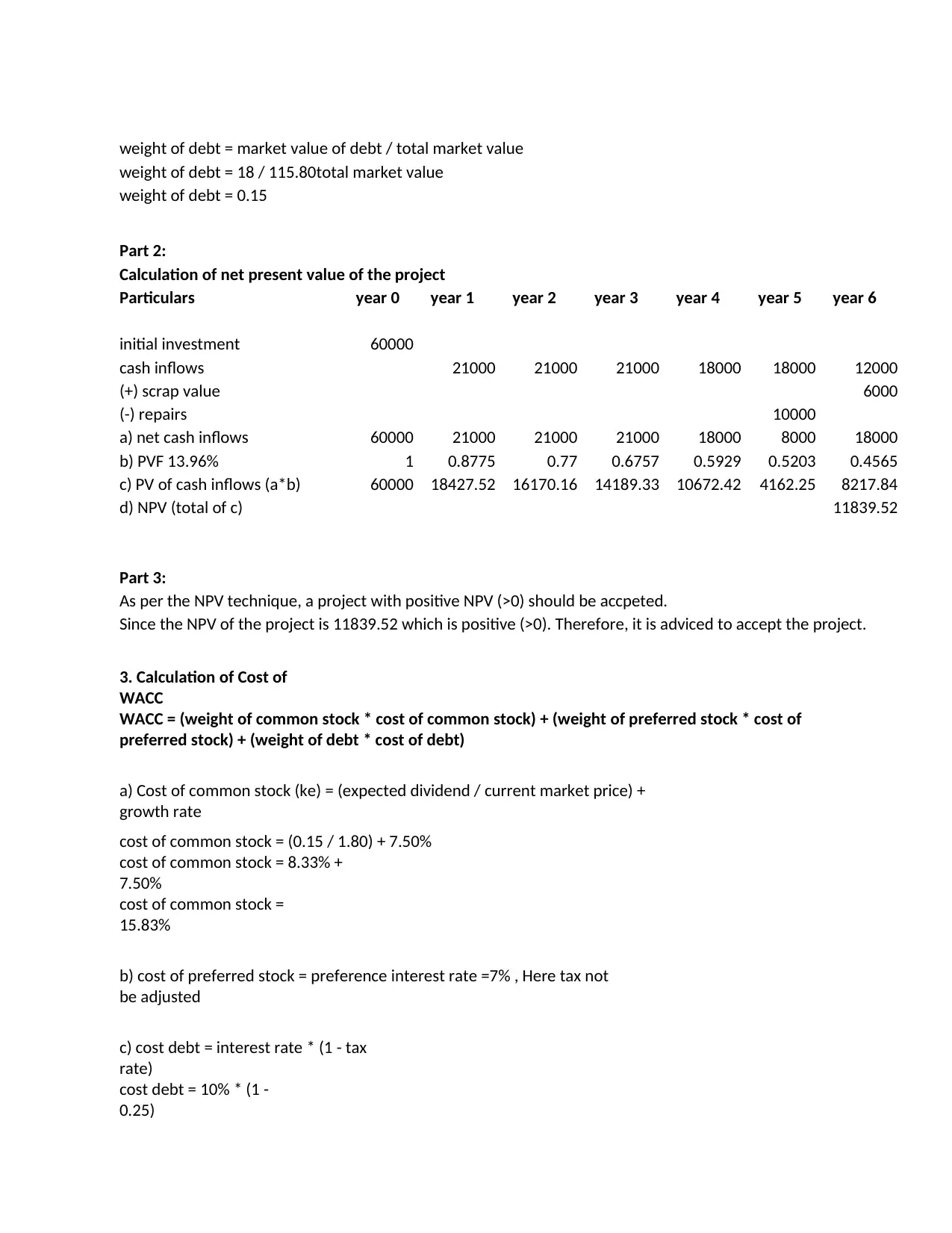
weight of debt = market value of debt / total market value
weight of debt = 18 / 115.80total market value
weight of debt = 0.15
Part 2:
Calculation of net present value of the project
Particulars year 0 year 1 year 2 year 3 year 4 year 5 year 6
initial investment 60000
cash inflows 21000 21000 21000 18000 18000 12000
(+) scrap value 6000
(-) repairs 10000
a) net cash inflows 60000 21000 21000 21000 18000 8000 18000
b) PVF 13.96% 1 0.8775 0.77 0.6757 0.5929 0.5203 0.4565
c) PV of cash inflows (a*b) 60000 18427.52 16170.16 14189.33 10672.42 4162.25 8217.84
d) NPV (total of c) 11839.52
Part 3:
As per the NPV technique, a project with positive NPV (>0) should be accpeted.
Since the NPV of the project is 11839.52 which is positive (>0). Therefore, it is adviced to accept the project.
3. Calculation of Cost of
WACC
WACC = (weight of common stock * cost of common stock) + (weight of preferred stock * cost of
preferred stock) + (weight of debt * cost of debt)
a) Cost of common stock (ke) = (expected dividend / current market price) +
growth rate
cost of common stock = (0.15 / 1.80) + 7.50%
cost of common stock = 8.33% +
7.50%
cost of common stock =
15.83%
b) cost of preferred stock = preference interest rate =7% , Here tax not
be adjusted
c) cost debt = interest rate * (1 - tax
rate)
cost debt = 10% * (1 -
0.25)
weight of debt = 18 / 115.80total market value
weight of debt = 0.15
Part 2:
Calculation of net present value of the project
Particulars year 0 year 1 year 2 year 3 year 4 year 5 year 6
initial investment 60000
cash inflows 21000 21000 21000 18000 18000 12000
(+) scrap value 6000
(-) repairs 10000
a) net cash inflows 60000 21000 21000 21000 18000 8000 18000
b) PVF 13.96% 1 0.8775 0.77 0.6757 0.5929 0.5203 0.4565
c) PV of cash inflows (a*b) 60000 18427.52 16170.16 14189.33 10672.42 4162.25 8217.84
d) NPV (total of c) 11839.52
Part 3:
As per the NPV technique, a project with positive NPV (>0) should be accpeted.
Since the NPV of the project is 11839.52 which is positive (>0). Therefore, it is adviced to accept the project.
3. Calculation of Cost of
WACC
WACC = (weight of common stock * cost of common stock) + (weight of preferred stock * cost of
preferred stock) + (weight of debt * cost of debt)
a) Cost of common stock (ke) = (expected dividend / current market price) +
growth rate
cost of common stock = (0.15 / 1.80) + 7.50%
cost of common stock = 8.33% +
7.50%
cost of common stock =
15.83%
b) cost of preferred stock = preference interest rate =7% , Here tax not
be adjusted
c) cost debt = interest rate * (1 - tax
rate)
cost debt = 10% * (1 -
0.25)
Secure Best Marks with AI Grader
Need help grading? Try our AI Grader for instant feedback on your assignments.
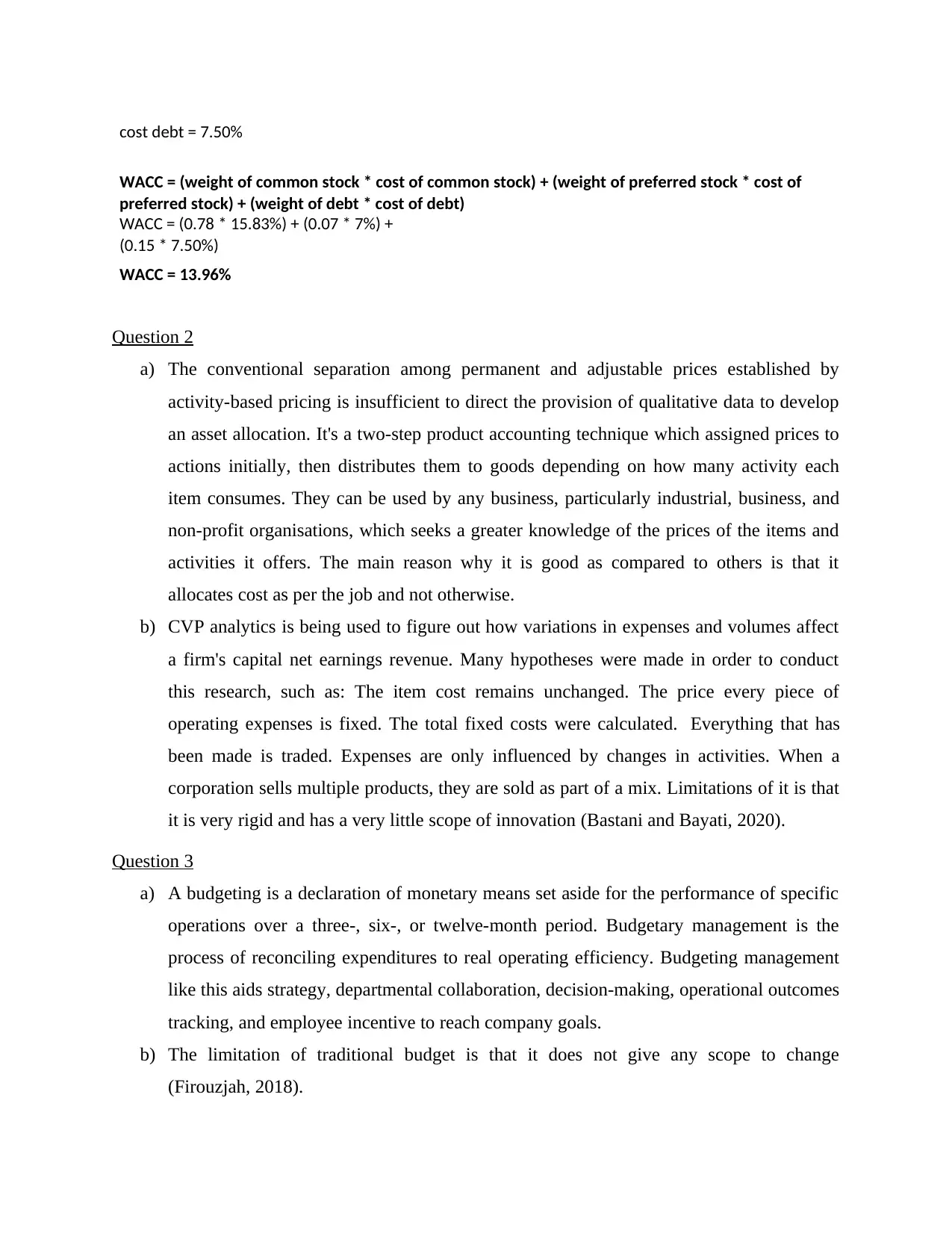
cost debt = 7.50%
WACC = (weight of common stock * cost of common stock) + (weight of preferred stock * cost of
preferred stock) + (weight of debt * cost of debt)
WACC = (0.78 * 15.83%) + (0.07 * 7%) +
(0.15 * 7.50%)
WACC = 13.96%
Question 2
a) The conventional separation among permanent and adjustable prices established by
activity-based pricing is insufficient to direct the provision of qualitative data to develop
an asset allocation. It's a two-step product accounting technique which assigned prices to
actions initially, then distributes them to goods depending on how many activity each
item consumes. They can be used by any business, particularly industrial, business, and
non-profit organisations, which seeks a greater knowledge of the prices of the items and
activities it offers. The main reason why it is good as compared to others is that it
allocates cost as per the job and not otherwise.
b) CVP analytics is being used to figure out how variations in expenses and volumes affect
a firm's capital net earnings revenue. Many hypotheses were made in order to conduct
this research, such as: The item cost remains unchanged. The price every piece of
operating expenses is fixed. The total fixed costs were calculated. Everything that has
been made is traded. Expenses are only influenced by changes in activities. When a
corporation sells multiple products, they are sold as part of a mix. Limitations of it is that
it is very rigid and has a very little scope of innovation (Bastani and Bayati, 2020).
Question 3
a) A budgeting is a declaration of monetary means set aside for the performance of specific
operations over a three-, six-, or twelve-month period. Budgetary management is the
process of reconciling expenditures to real operating efficiency. Budgeting management
like this aids strategy, departmental collaboration, decision-making, operational outcomes
tracking, and employee incentive to reach company goals.
b) The limitation of traditional budget is that it does not give any scope to change
(Firouzjah, 2018).
WACC = (weight of common stock * cost of common stock) + (weight of preferred stock * cost of
preferred stock) + (weight of debt * cost of debt)
WACC = (0.78 * 15.83%) + (0.07 * 7%) +
(0.15 * 7.50%)
WACC = 13.96%
Question 2
a) The conventional separation among permanent and adjustable prices established by
activity-based pricing is insufficient to direct the provision of qualitative data to develop
an asset allocation. It's a two-step product accounting technique which assigned prices to
actions initially, then distributes them to goods depending on how many activity each
item consumes. They can be used by any business, particularly industrial, business, and
non-profit organisations, which seeks a greater knowledge of the prices of the items and
activities it offers. The main reason why it is good as compared to others is that it
allocates cost as per the job and not otherwise.
b) CVP analytics is being used to figure out how variations in expenses and volumes affect
a firm's capital net earnings revenue. Many hypotheses were made in order to conduct
this research, such as: The item cost remains unchanged. The price every piece of
operating expenses is fixed. The total fixed costs were calculated. Everything that has
been made is traded. Expenses are only influenced by changes in activities. When a
corporation sells multiple products, they are sold as part of a mix. Limitations of it is that
it is very rigid and has a very little scope of innovation (Bastani and Bayati, 2020).
Question 3
a) A budgeting is a declaration of monetary means set aside for the performance of specific
operations over a three-, six-, or twelve-month period. Budgetary management is the
process of reconciling expenditures to real operating efficiency. Budgeting management
like this aids strategy, departmental collaboration, decision-making, operational outcomes
tracking, and employee incentive to reach company goals.
b) The limitation of traditional budget is that it does not give any scope to change
(Firouzjah, 2018).
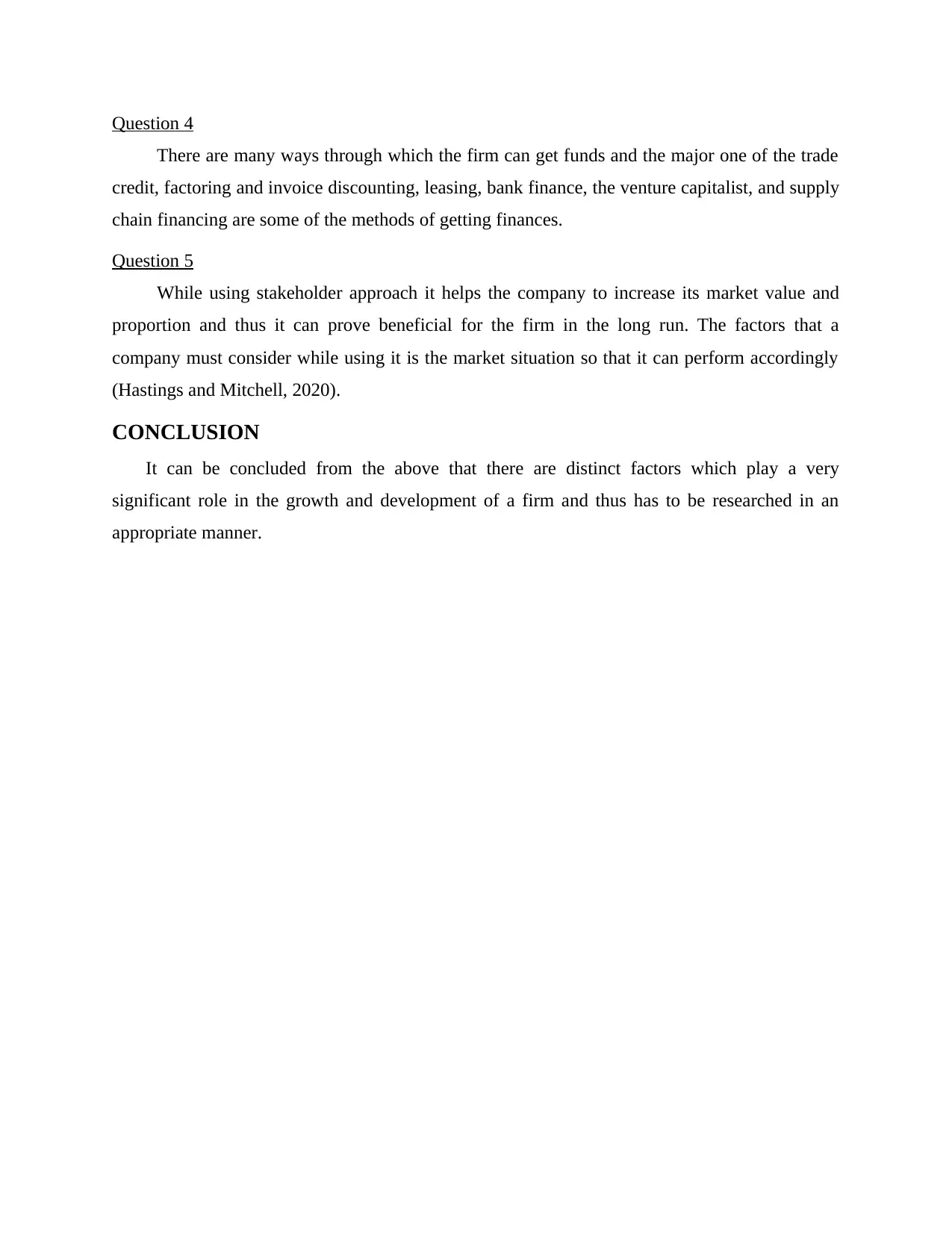
Question 4
There are many ways through which the firm can get funds and the major one of the trade
credit, factoring and invoice discounting, leasing, bank finance, the venture capitalist, and supply
chain financing are some of the methods of getting finances.
Question 5
While using stakeholder approach it helps the company to increase its market value and
proportion and thus it can prove beneficial for the firm in the long run. The factors that a
company must consider while using it is the market situation so that it can perform accordingly
(Hastings and Mitchell, 2020).
CONCLUSION
It can be concluded from the above that there are distinct factors which play a very
significant role in the growth and development of a firm and thus has to be researched in an
appropriate manner.
There are many ways through which the firm can get funds and the major one of the trade
credit, factoring and invoice discounting, leasing, bank finance, the venture capitalist, and supply
chain financing are some of the methods of getting finances.
Question 5
While using stakeholder approach it helps the company to increase its market value and
proportion and thus it can prove beneficial for the firm in the long run. The factors that a
company must consider while using it is the market situation so that it can perform accordingly
(Hastings and Mitchell, 2020).
CONCLUSION
It can be concluded from the above that there are distinct factors which play a very
significant role in the growth and development of a firm and thus has to be researched in an
appropriate manner.
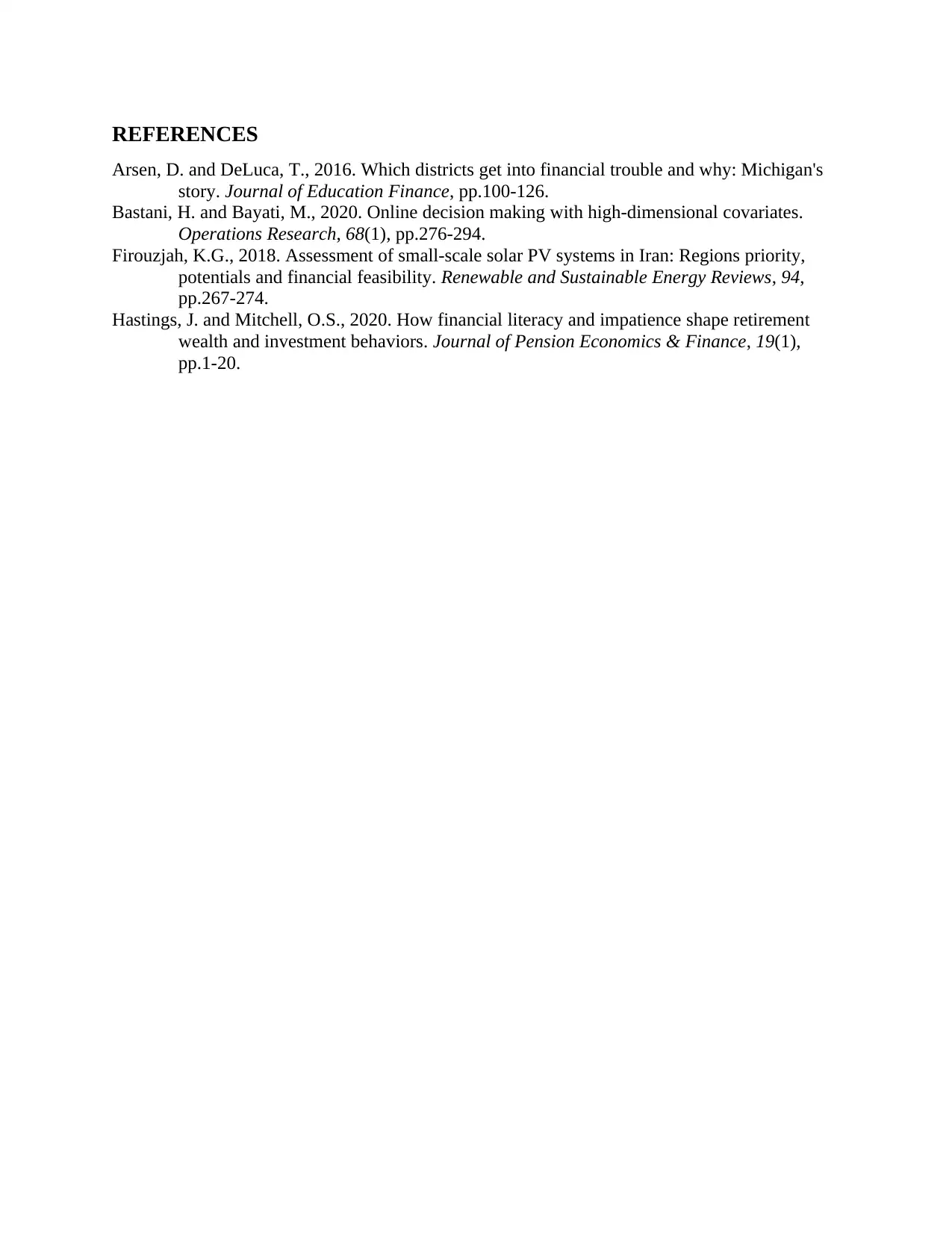
REFERENCES
Arsen, D. and DeLuca, T., 2016. Which districts get into financial trouble and why: Michigan's
story. Journal of Education Finance, pp.100-126.
Bastani, H. and Bayati, M., 2020. Online decision making with high-dimensional covariates.
Operations Research, 68(1), pp.276-294.
Firouzjah, K.G., 2018. Assessment of small-scale solar PV systems in Iran: Regions priority,
potentials and financial feasibility. Renewable and Sustainable Energy Reviews, 94,
pp.267-274.
Hastings, J. and Mitchell, O.S., 2020. How financial literacy and impatience shape retirement
wealth and investment behaviors. Journal of Pension Economics & Finance, 19(1),
pp.1-20.
Arsen, D. and DeLuca, T., 2016. Which districts get into financial trouble and why: Michigan's
story. Journal of Education Finance, pp.100-126.
Bastani, H. and Bayati, M., 2020. Online decision making with high-dimensional covariates.
Operations Research, 68(1), pp.276-294.
Firouzjah, K.G., 2018. Assessment of small-scale solar PV systems in Iran: Regions priority,
potentials and financial feasibility. Renewable and Sustainable Energy Reviews, 94,
pp.267-274.
Hastings, J. and Mitchell, O.S., 2020. How financial literacy and impatience shape retirement
wealth and investment behaviors. Journal of Pension Economics & Finance, 19(1),
pp.1-20.
1 out of 7
Related Documents
Your All-in-One AI-Powered Toolkit for Academic Success.
+13062052269
info@desklib.com
Available 24*7 on WhatsApp / Email
![[object Object]](/_next/static/media/star-bottom.7253800d.svg)
Unlock your academic potential
© 2024 | Zucol Services PVT LTD | All rights reserved.




